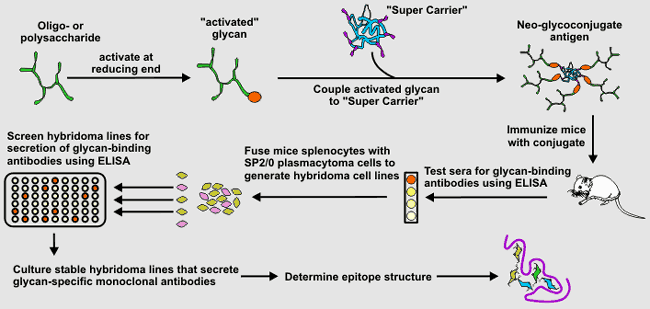 |
|||||||
 |
|||||||
Specific Goals:
Glycoconjugate Immunobiology Most polysaccharides are weakly immunogenic and do not stimulate the production of high titers of antibodies. This is due in large part to the fact that the response to polysaccharides is believed to be T cell-independent. In contrast, proteins which are highly antigenic stimulate a T cell-dependent response. To generate a glycan that will stimulate a T cell-dependent response requires the use of glycoconjugate antigens in which an oligo- or polysaccharide is covalently coupled to a protein (Jennings and Sood [1994]. Synthetic glycoconjugates as human vaccines. In Neoglyconjugates: Preparation and Applications. Acadmeic Press, pp. 325-371). An important consideration during the synthesis of glycoconjugate antigens is to minimize changes in structure and conformation of the individual components. Many plant polysaccharides have acid (furanose and keto residues) and base (O-acetyl, methyl esters) sensitive substituents. Such residues may be important for antigenicity. Thus, procedures to couple oligo- and polysaccharides to proteins must be sufficiently mild to retain the primary structure of the glycan. Moreover, immunogenicty is likely to be dependent on the three dimensional structure of the polysaccharide. Antibodies that recognize carbohydrates typically bind to structural motifs (epitopes) composed of one to six glycoses. However, the conformation of such short chain oligosaccharide epitopes may depend on their structural context within a larger oligo- or polysaccharide. Thus the choice of immunogen (short oligosaccharide, longer oligosaccharide, or polysaccharide) may influence whether or not antibodies capable of binding to the native polysaccharide in the wall are obtained.. A overview of our experimental approch for generating and characterizing monoclonal antibodies that recognize plant cell walls is shown in the figure below: |
Follow the links below the image to obtain more information  |
|
|
| [Home] | [People] | [Background] | [Research Plan] | [Wall Antigens] | [Antibodies] | [Facilities] | [Links] |
|
|
| A National Science Foundation-funded (Grant No DBI-0421683) research project at The Complex Carbohydrate Research Center of The University of Georgia |